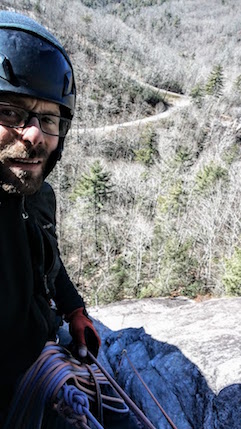Friendly Reminder on Permit/Insurance Sharing for Guides and Instructors
This article was written by Ed Crothers in the Mountain Bulletin last year, but still pertains to everyone in the profession. Some key points from the article: If you are guiding and using permits from organizations and/or guide services with which you are not closely familiar, remember to ask for a copy of the permit to ensure that the activities you’re participating in are covered. The IRS tax code states that “no part of the net earnings of a section 501(c)(3) organization may inure to the benefit of any private shareholder or individual.” This is why the AMGA is unable to allow individuals to guide or instruct private clients under our insurance and umbrellas. The latter part of this article does a great job describing the different permits available under the National Park Service (NPS) and the US Forest Service (USFS). If you have any questions, please feel free to contact Ed Crothers ([email protected]) or Scott Massey, Outreach and Advocacy Director ([email protected]).
Permit/Insurance Sharing: Too Good To Be True?
By Ed Crothers, AMGA Accreditation and Climbing Instructor Program Director
In the Spring 2011 issue of the Mountain Bulletin, Don Pachner wrote a very informative article about concerns within the insurance industry regarding permit sharing. His article was geared toward permit sharing among guide services and climbing schools. This article will focus on concerns the independent guide should be aware of if considering using shared permits and liability insurance when guiding his or her own clients.
When entering into a permit and insurance sharing relationships it would be foolish to not “look a gift horse in the mouth.” There are three main areas of concerns: liability insurance coverage, worker classification, and permit regulations and restrictions. While I will look at all three of these individually, it will become apparent that they are all interconnected. Also, with the lack of uniformity between general liability insurance policies, public lands permitting regulations, and state and federal labor laws, it is not in your best interest to blindly jump into one of these arrangements. While ignorance of the law is not an excuse, the complexity of trying to work through this maze of issues can be overwhelming. The intent of this article is to give guides and climbing instructors an idea of some of the issues they need to be aware of and questions they should be asking when considering sharing permits and insurance.
Liability Insurance Coverage
At the top of the list of concerns is general liability insurance coverage. Federal and state agencies require any permit holder to carry general liability insurance that covers the activities for which the permit is issued and sets specific dollar amounts of coverage. Not all general liability insurance policies are created equal. The amount of coverage can vary considerably from one policy to the next. Endorsements, amendments, and exclusions will all affect the coverage the policy offers. When considering operating under another entity’s liability insurance, it is essential that you know you are truly covered for the activities you offer clients. Request a copy of the policy and the name of the insurance broker who wrote the policy. If that information is not provided, that should be considered a red flag. Once you have a copy of the policy, a good course of action is to contact the broker, explain your interest in taking advantage of the permit/insurance sharing program, and ask if you are truly covered for the activities you will be engaged in. If the answer is no, that should be an obvious deal breaker. Without proper coverage you will not only be operating illegally, but in the event of a serious incident, you will find yourself personally liable for any damages awarded by the court if you are successfully sued. The attitude that “if I don’t have many assets to lose, no big deal” is incorrect, ethically wrong and not the mindset of a professional. Additionally, if you are considering offering international trips, you want to be certain that the policy is in effect outside the United States.
Worker Classification
The important question here is what will be your contractual relationship with the organization you are sharing permits or insurance with. You need to ascertain if you are an employee, independent contractor, owner, or “other.” This is important to know because that relationship will factor into the validity of permits and liability insurance coverage. Once you know that relationship you can begin to ask specific questions. Additionally, the IRS classification of the permit holder comes into play for some permits, in particular National Park Service permits. More on that below.
Employee: As an employee, you are entitled to certain legal rights and the employer has to comply with state and federal labor laws. The employer is responsible for paying Social Security, unemployment insurance, Medicare, and possibly other costs. At the end of the tax year, the employer is responsible for compiling all necessary payroll reports, including W-2 forms. An important regulation to be aware of is that the “employer” is required to carry Workers Compensation Insurance for both the state the activity will take place in, as well as, the state you live in. Ask for proof of Workers Comp Insurance to ensure that you are protected in the event of an on-the-job incident.
Independent Contractor: As an independent contractor you will have a challenging route to navigate. It is questionable whether independent contracting as an “outfitter or guide” is even legal on NPS and USFS lands. Again, be certain that the entity’s liability insurance covers independent contractors. If not, you will want to purchase your own general liability insurance. To protect your personal assets, consider creating some sort of business structure, something like a single-member LLC. If the income you generate under the permit/insurance sharing program is over $600, you will be responsible for reporting your federal and state taxes quarterly. Make sure the permit holder will be issuing you an IRS Form 1099 at the end of the year. Be aware that if the IRS audits the permit holding entity, and determines workers were misclassified as independent contractors instead of employees, there will be big blow back on the entity, but the independent contractor is likely to, at best, be audited, at worse, pay back taxes and face additional penalties.
Owner: Co-operatives fall into this category. As a member of a co-op you are an owner. Ownership exempts the co-op from having to purchase things such as Workers Compensation insurance because there are no employees. As pointed out earlier, you want to take a careful look at the general liability insurance; does the policy cover the appropriate activities and is it in effect outside of the U.S?
Member: Membership is not a worker classification and would fall under the category of “other.” If you intend to purchase a membership as a way to access a permit and insurance sharing program your first question should be “member of what?” Next you want to determine your true worker classification.
As mentioned above, in a for-profit cooperative a membership equates to being an owner. Membership in a non-profit 501(c) 3 to access permits and insurance is considerably different and must be approached with caution. First thing to be aware of is the exempt purpose for which an organization was granted 501 (c) 3 non- profit status. In our line of work, that exempt purpose is going to be “educational.” Next, while a 501(c) 3 non- profit can generate tax-free income, those tax-free profits can only be used for operating expenses (including salaries for employees) or for the benefit of the organization. According to the IRS Tax Code, “no part of the net earnings of a section 501(c)(3) organization may inure to the benefit of any private shareholder or individual.” In the case of the AMGA, a 501(c) 3, the exempt purpose is as an “educational” organization, in particular, the training and certification of mountain guides and climbing instructors. While the AMGA can and does hire employees to “train and certify mountain guides and instructors,” individuals guiding or instructing their private clients under the umbrella of the AMGA insurance and permits would be a clear violation of the IRS tax code.
So, it is legal if the individuals are employees that are engaged in the exempt purpose of the non-profit, but illegal for members or other shareholders generating income for themselves engaged in activities outside of an organization’s exempt purpose. If you are told that, as a member, you can use the organization’s permit and insurance, dig deeper and take a closer look at what that really means. As mentioned earlier, as an employee you are entitled to certain rights and the employer needs to be in compliance with state and federal regulations.
Permits
Always a complex topic. Agencies offer different types of permits, have different regulations for non-profit and for profit organizations, and are often interpreted differently, even within the same agency. This article will limit itself to the National Park Service and U.S. Forest Service commercial use permit regulations. Be aware that other federal agencies, municipalities, and private property owners will have their own rules and regulations. Typically, what they all have in common is that the permit holder or commercial operator carry general liability insurance and list the permitting entity as additionally insured.
National Park Service– The NPS offers three types of permits; concession, commercial use authorizations (CUA), and special use permits (SUP).
Concessions: Typically, these are multi-year permits, up to 10 years. In order to share a permit with a concessionaire, you must be an employee of the concessionaire, unless allowing sub-concessionaires or third
parties is written into the concession contract. (See NPS Management Policy 2006 handbook, page 145, section 10.2.3.5). Amending a multi year concessions contract to allow independent contractors is unlikely. As an employee, you can only provide services for which the permit was issued. Get a copy of the permit and be sure that the activities you will be engaged in are included on the permit. Typically, that information appears on page 1 of the permit.
CUA: These are short-term permits, 2 years maximum. They are available to both for profit and non-profits businesses. However, CUAs are only available to non-profits if the organization generates taxable income as defined by the IRS Tax Code. If the CUA holder is a 501 (c) 3 non-profit, it is likely nothing more than a clerical error on the part of the Park, but technically CUAs are not issued to a 501 (c) 3. Like concessions, they are issued for specific activities and can only be transferred with written permission from the Park Superintendent. Request a copy of the permit.
SUP: 501 (c) 3 non-profits can get access to NPS permits through Special Use Permits (SUP). However, permit sharing with a 501 (c) 3 has serious limitations. Like concessions and CUAs, the permit is issued for specific activities that are listed on the permit. For example, the SUP the AMGA holds for Rocky Mountain National Park states the purpose is for “training and certification of mountain guides.” Any services offered under this permit that are not for the purpose of “training and certification” would be in violation of the terms of the permit. Operating without appropriate permits is a dangerous game to play.
Equally important with SUPs is that if you were working with your own clients, it would be very difficult to claim that you are not generating what the IRS would consider to be taxable income. As mentioned earlier, that is something a 501 (c) 3 is not allowed to do.
Finally, SUPs cannot be transferred or subcontracted out without written permission of the particular Park Superintendent. This comes back to the question of your contractual relationship with the permit holder. In the case of the NPS, unless the Park Superintendent has given permission to allow subcontracting, you must be an employee of the permit holder. You cannot be an independent contractor; that would be illegal.
US Forest Service
The structure of the USFS makes it a challenging government agency to understand when it comes to permitting. National Forests are subdivided into Ranger Districts. It is not uncommon for one National Forest to consist of 10+ Ranger Districts. While Ranger District employees answer to the Forest Supervisors Office and that office answers to a Regional Office, the USFS subscribes to a decentralized decision making process. While the upper levels give guidance, most management decisions are made at the lower levels of the agency. As a result, there can be wide ranging interpretation of the rules and regulations for issuing commercial use permits from one Ranger District to the next within the same National Forest.
Another thing to be aware of is that commercial use permits are not issued for an entire National Forest; they are issued by individual Ranger Districts. In desirable climbing locations in National Forests around the U.S., it is likely there will be multiple Ranger Districts involved in the permitting process. How that ties into permit sharing is that you need to be aware of what Ranger District you will be working on, and that the shared permit includes that district. As an example, an entity that holds a permit for the Boulder Ranger District in Arapahoe- Roosevelt National Forest does not have carte blanche to guide in the Hot Sulphur Springs Ranger District in the Arapahoe-Roosevelt N.F., another permit is required for that district. Get a copy of the permit to make certain you will be guiding where you are legally authorized to operate.
The USFS classifies people in our line of work as “outfitters and guides.” Under that classification there are two types of permits that are available – Priority Use and Temporary Use. In simplest terms the only difference between the two is that one is long term, the other is short term. Both types of permits are subject to the same regulations that can be found in U.S. Forest Service Special Uses Handbook FSH 2709.11, Chapter 40. Of most importance to someone sharing permits and insurance is Section 41.53i-Requirements for Temporary and
Priority Use Permits, where the question of operating as an independent contractor is addressed in paragraph 5, sub-paragraphs a. to d. Unlike the NPS regulations, there is a gray area as to when it is legal to work as an independent contractor. However, what is clear is that the permit holder must have received “prior written approval of the authorized (USFS) officer.” This written approval requires the permit holder “…to submit the contract for these (ancillary) services with their application or at the beginning of each operating season…” If you are permit sharing on USFS lands as an independent contractor, it is not as if you can just show up and you are good to go. The permit holder must have made arrangements prior to the start of the operating season.
Like the NPS, the permit is issued for specific activities. Get a copy of the permit and make sure the permitted activities correspond with the activities you and your clients will be taking part in.
In summary, ask questions, get and review copies of permits and insurance policies, and know your worker classification. When in doubt, seek out the help of a qualified professional. Keep in mind that if something appears too good to be true, it likely is.












